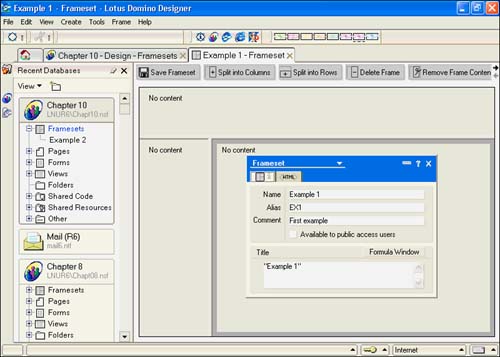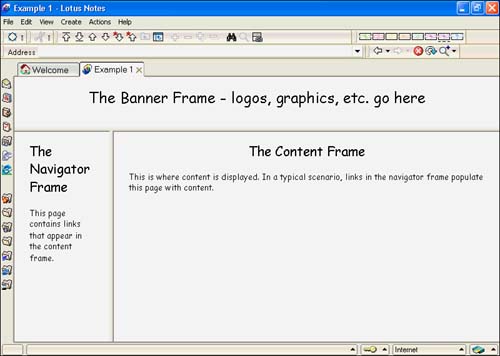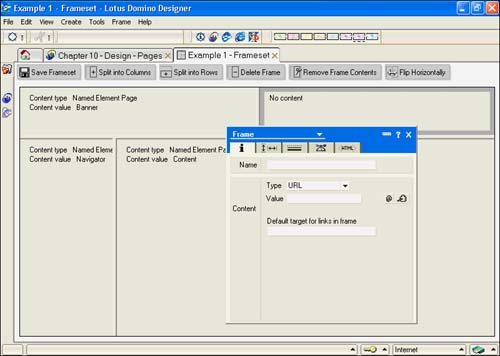Using the Frameset Designer
The Frameset Designer is pretty straightforward. After all, most of the action happens in the frames themselves. However, you should be aware of a properties box and some menu choices before moving on to designing the frames themselves . Figure 10.4 shows the Frameset Designer with the properties box open to the Basics tab.
Figure 10.4. The Frameset Designer has four buttons to alter the appearance of the frames and frameset.

Before you save your new frameset, you must name it and optionally provide an alias and title. The title can be plain text, as in this example, or you can write a formula to calculate the title. If you don't add a title, the frameset displays "Untitled" in the Window tab. For you HTML fans, this becomes the HTML page title, enclosed in the container tag
. Titles are displayed in the Window tab of the Notes client, as shown in Figure 10.5.
Figure 10.5. This figure shows a typical frameset with navigator, banner, and content frames. Note the name of the frameset, Example 1, in the Window tab.

The HTML tab contains the standard settings and is not discussed here.
Using the View and Frame Menus
Whenever you work in a frameset, a new choice appears in the View menu and a new menu appears, the Frame menu. The View menu contains two options, Refresh All option and Show Frame Content. Refresh All refreshes the content of all frames within the frameset. Show Frame Content is a toggle that turns the display of the frame contents in the Frame Designer on and off. When it's turned on, you can see the pages and other objects that you are displaying in a frame "live." When it's turned off, frames display the background color with text indicating the content type and value of each frame. With Show Frame Content turned on, you can more easily adjust the sizes of the frames to fit the contents.
CAUTION
If you have Show Frame Content turned on and the contents of a frame consist of an Internet URL, that link is displayed in the frame during design. This is not a problem as long as you have a constant connection to the Internet, but if you have a dial-up connection, Domino dials your Internet service provider.
The Frame menu has the following choices:
- Frameset Properties ” Displays the Frameset properties box.
- Frame Properties ” Displays the Frame properties box for the selected frame.
- Split into Columns ” Splits the selected frame into columns.
- Split into Rows ” Splits the selected frame into rows.
- Delete Frame ” Deletes the selected frame.
- Refresh Frame Content ” Refreshes the content of the selected frame.
- Remove Frame Content ” Removes the content of the selected frame.
- Preview in Notes ” Launches the frameset in the Notes client. You are prompted to save any changes.
- Preview in Web Browser ” Launches the frameset in the default Web browser. You are prompted to save any changes.
NOTE
You have much more control over the preview choices from the button bar than from the context menu. Because choosing a preview type is a single click on a button, it is also more efficient. From the button bar, you can see buttons for Notes Preview, Notes Browser Preview, Internet Explorer Preview (if installed), and Netscape Preview (if installed).
Four of the choices on the Frame menu have corresponding buttons in the Frameset Designer: Split into Columns, Split into Rows, Delete Frame, and Remove Frame Contents. Refresh Frame Content does not have a corresponding button. Refreshing the frame content is useful if you work on a page or other design element that you've linked in a frame while the Frameset Designer is open. To see the changes to the element, choose Refresh Frame Content.
TIP
You can right-click a frame in the Frameset Designer. A context menu is displayed with the same menu choices. For example, you can refresh the content of an individual frame by right-clicking the frame and choosing Refresh Frame Content from the context menu.
The Frameset Designer has six buttons, only two of which aren't available from the Frames menu:
- Save Frameset ” Saves the frameset
- Flip Horizontally ” Switches the positions of two frames that are beside each other
CAUTION
As of this writing, the Flip Horizontally button flips all horizontally adjacent frames in a frameset. For example, if you have four frames, the two on the right will now be on the left, and the two on the left will now be on the right.
Splitting Frames in a Frameset
You are by no means limited to the 12 basic layouts, nor are you limited to the number of frames in the Create New Frameset window. When you've created a basic frameset, you can split any frame into new frames either vertically (Split into Columns) or horizontally (Split into Rows). For example, you could start with the basic three-paned layout shown in Figure 10.5 and add a frame to the upper-right corner for a logo. To do this, click in the topmost frame, the "banner" frame. You should notice that the frame has a thick gray border when selected, so you can always tell which frame you're working with. Click the Split into Columns button, and a new frame is added to the right of the existing frame (see Figure 10.6).
Figure 10.6. The top frame has been split vertically into two frames. The thick bar in the frame at the upper right indicates that it is the frame currently selected.

TIP
You can also use another frameset in a frame to give additional flexibility and more frames.
The sizes of each frame can be easily changed as well. Simply grab the frame border with the mouse, and click and drag it to the desired position. You can also alter the size of frames using the Frame properties box, which is discussed next in the section titled "Working with Frames."
Now that you've learned how to create a basic frameset, add new frames, and resize the existing frames, you're ready to begin working with the contents of the frames themselves.
Part I. Introduction to Release 6
Whats New in Release 6?
- Whats New in Release 6?
- A Brief History of Lotus Notes
- Major Features of Lotus Notes
- Types of Applications
- Whats New in Domino Designer?
- New Design Element Features
- New Language Features
The Release 6 Object Store
- The Release 6 Object Store
- Defining a Domino Database
- Understanding the Database Structure
- Creating a Database
- Working with Database Properties
- Understanding Design Templates
- Creating Your Own Templates
- Inheriting Designs from Templates
- Using Templates to Replicate Design Changes
- Using Templates as Design Libraries
- Archiving Versions with Templates
The Integrated Development Environment
- The Integrated Development Environment
- Working in the Application Design Environment
- Working with the Properties Box
- Understanding the Work Pane
- Using the Programmers Pane
- Understanding the Info List
- Understanding the Action Pane
- Customizing the Tools Menu
- Printing Source Code
- Using the HTML Editor
- Locking Design Elements
Part II. Foundations of Application Design
Forms Design
- Forms Design
- Designing Forms
- Setting Form Properties
- Working with Text Properties
- Working with Fields
- Writing Formulas in Fields
Advanced Form Design
- Advanced Form Design
- Working with Tables
- Using Graphic Objects on Forms
- Working with Form-Level Events
- Using Form Actions
- Working with Hotspots
- Understanding Sections and Section Properties
- Using Layout Regions
- Working with Special Forms
- Creating Reusable Design Objects
- Using Embedded Elements
- Using the Form Design Document
Designing Views
- Designing Views
- Defining the Elements of a View
- Creating a View
- Setting View Properties
- Creating Advanced View Selections
- Adding and Editing View Columns
- Using View Column Properties
- Adding Actions to a View
- Creating Calendar Views
- Understanding Folders
Using Shared Resources in Domino Applications
- Shared Resources
- Sharing Images Within a Database
- Creating Shared Files
- Creating Shared Applets
- Shared Code
- Creating Subforms
- Creating Shared Fields
- Creating Shared Actions
- Script Libraries
- Database Resources
Using the Page Designer
- Using the Page Designer
- Understanding Pages
- Working with the Page Properties Box
- Using the Page Designer
- Adding Layers to Your Pages
Creating Outlines
- Creating Outlines
- Creating an Outline
- Working with Outline Entries
- Embedding Outlines
- Adding an Outline to a Frameset
Adding Framesets to Domino Applications
- Adding Framesets to Domino Applications
- Creating a Frameset
- Using the Frameset Designer
- Working with Frames
- Viewing the HTML Source of Your Frameset
- Launching the Frameset
Automating Your Application with Agents
- Automating Your Application with Agents
- Working with Agents
- Creating an Agent
- Working in the Agent Builder Design Window
- Using @Commands in Agents
- Putting Your Agent to Work
- Creating a Complex Agent
- Using LotusScript in Agents
- Creating Web Agents Using Formulas and LotusScript
- Using Java in Agents
- Testing and Debugging Agents, the Agent Log, and Agent Properties
- Agent Properties via the Agent InfoBox
Part III. Programming Domino Applications
Using the Formula Language
- Using the Formula Language
- Overview of the Formula Language
- Knowing Where to Use @Functions and @Commands
- Formula Syntax
- Limitations of the Formula Language
- Working with Statements
- Using Logical @Functions
- Working with Date and Time @Functions
- Working with Strings
- Getting Session and User Information
- Working with Documents
- Retrieving Data with @DbColumn and @DbLookup
- Working with Lists
- Getting User Input
- Controlling the Flow of a Formula
- Error Handling
Real-World Examples Using the Formula Language
- Real-World Examples Using the Formula Language
- Programming Practices
- Using Formulas in Forms and Subforms
- Writing Field Formulas
- Writing View Formulas
- Using Hide When Formulas
- Working with Forms, Views, and Shared Actions
Writing LotusScript for Domino Applications
- Writing LotusScript for Domino Applications
- Software Construction
- Fundamental Elements of LotusScript
- New Technologies and LotusScript
Real-World LotusScript Examples
- Real-World LotusScript Examples
- Real-World Example 1: Importing a Delimited Text File
- Real-World Example 2: Delete a Parent Document and All Its Children: DeleteParentAndChildren
- Real-World Example 3: Schedule an Agent Robot to Refresh All the Documents in a View: Robot-DailyRefreshAllDocs
- Real-World Example 4: Return a Web User to the Place Where He Started After a Document Is Submitted: WebQuerySave-DocSubmit
Writing JavaScript for Domino Applications
- Writing JavaScript for Domino Applications
- What Is JavaScript?
- JavaScript Is Not Java
- JavaScript and the Domino IDE
- The Document Object Model
- JavaScript Support in Domino 6
- When to Use JavaScript
- A Look at JavaScript in Domino
- JavaScript Libraries in Domino
- JavaScript Principles 101
- Syntax and Command Blocks
- Statements
- Output
- Functions
- Objects
- Input Validation
- Validating Check Boxes
- Validating Radio Buttons
- Validating Selection Lists
- Calculations
- JavaScript Application
Real-World JavaScript Examples
- Real-World JavaScript Examples
- Real-World Example 1: Dynamic Drop-Down Lists on the Web
- Real-World Example 2: Dialog Boxes and window. opener on the Web
- Real-World Example 3: Dynamic Tables
- Real-World Example 4: Useful JavaScript Utilities
Writing Java for Domino Applications
- Writing Java for Domino Applications
- Introduction to Java
- Choosing a Java Solution in Domino
- Understanding the Notes Object Interface
- Writing Java Agents
- Using Other Java IDEs
- Other Uses for Java
Real-World Java Examples
Enhancing Domino Applications for the Web
- Enhancing Domino Applications for the Web
- Whats New in Designer 6
- Understanding the Domino Web Application Server
- Understanding the Basics of HTML
- Using HTML in Domino Designer
- Adding Power with Domino URLs
- Views and Forms Working Together on the Web
- Incorporating Flash into Your Web Pages
- What Its All About: XML Exposed
- How Does Domino Use XML?
Part IV. Advanced Design Topics
Accessing Data with XML
Accessing Data with DECS and DCRs
- Accessing Data with DECS and DCRs
- What Is DECS?
- The External Data Source
- DECS Administrator
- Creating the Activity
- Accessing the Application
- DECS Summary
- Data Connection Resources
- DCR Example
- Tips on External Data Access
Security and Domino Applications
- Security and Domino Applications
- How Does Domino Security Work?
- Enabling Physical Security
- Setting Server Access
- Database Access Control Lists
- The Role of the Domino Directory in Application Security
- ACL Privileges
- Enabling Database Encryption
- Using Roles
- Implementing View-Level Security
- Implementing Form-Level Security
- Implementing Document-Level Security
- Applying Field-Level Security
- Hiding the Design of Your Application
Creating Workflow Applications
- Creating Workflow Applications
- The Evolution of Groupware
- Introducing Workflow
- Creating Mail-Enabled Applications
- Using Triggers to Send Email
- Sending Mail with LotusScript
Analyzing Domino Applications
Part V. Appendices
Appendix A. HTML Reference
Appendix B. Domino URL Reference
EAN: 2147483647
Pages: 288
